HISTORICAL MINIATURES JOURNAL ISSUE NUMBER 17
PUBLISHED
BY GEORGE GRASSE
BRITISH CAVALRY AT WATERLOO
MODELING 54mm
HISTOREX KITS, Part 3: 7th QUEEN'S OWN LIGHT DRAGOONS (HUSSARS) REGIMENT
SERVICE RECORD SUMMARY AT WATERLOO
The 7th Queen's Own Light Dragoons (Hussars), hereafter 7th Hussars, was brigaded
with the 15th King's Own Hussars and the 2nd King's German Legion Hussars
(detached) as the 5th Cavalry Brigade commanded by Major General Sir Colquhoun
Grant, in the Cavalry Corps of Wellington's Army at the Battle of Waterloo, 18
June 1815.
Grant's Brigade had present for duty including the 2nd KGL
Hussars was 63 officers and 1,268 other ranks for a
grand total of 1,331 troops. The 7th Hussars had three squadrons at Waterloo with a
present-for-duty strength of 18 officers and 385 other ranks.
It lost at Waterloo the following: officers: 2 killed, 7
wounded, 3 missing; other ranks: 62 killed, 109 wounded, 15 missing; total loss
was 198 out of 403. See table below.
| Regiment |
Present |
Killed |
Wounded |
Missing |
Total |
% Loss |
| 7th Queen's Own Hussars |
403 |
64 |
116 |
18 |
198 |
49% |
| 15th King's Own Hussars |
456 |
24 |
54 |
5 |
83 |
18% |
| 2nd KGL Hussars |
not engaged at Waterloo; at Courtrai,
Belgium |
| 5th Cavalry Brigade Total |
859 |
88 |
170 |
23 |
281 |
33% |
The brigade was initially posted at the junction of the Nivelles-Wavre road,
probably south of Mont St. Jean. According to General Sir Evelyn Wood, in
his book Cavalry in the Waterloo Campaign, page 168, the British 13th
Light Dragoon Regiment of Arenschildt's 7th Cavalry Brigade, joined Grant's
brigade, and the three regiments were sent to the Army's right flank to meet a
perceived attack by Piré's French Lancer brigade
between 3:00 and 4:00 pm. Piré retired on
Grant's approach. At approximately 4:00 pm, Maréchal Ney ordered the
commencement of the grand cavalry attack against Wellington's right center.
Grant's brigade did not participate until the French cavalry retreated, each
regiment charging different groups of retiring cavalry. Other cavalry
participated until the whole affair was terminated after something like twelve
distinct French cavalry charges.
UNIFORM DESCRIBED
British hussar regiments were individually dressed as to uniform color,
piping color, and facing color but the
uniform articles were all the same, especially the unique hussar dolman and the
heavier article often slung on the shoulder, the pelisse. For the 7th
"Queen's Own" Hussars, the dolman, pelisse, and trousers were dark blue.
All piping was yellow including dolman and pelisse braid. Buttons were
brass. The facing color was the same color as the uniform clothing, dark
blue. Collar and cuffs were highly decorated with several strands of
looped piping. The waist sash was dark red with yellow barrels and a red
double cord with yellow tassels attached at the rear, looped around the upper
right thigh, and attached to the front of the waist sash. The pelisse fur
was black.
The busby (or colpack) was dark brown with an unadorned red bag. Yellow
cap lines wrapped around the center of the busby and fell behind the bag, which
was allowed to fall to the right, where it was attached to buttons on the right
upper chest with a decorative pair of yellow raquettes. The plume was
white with a red base extending one-third of the way up the plume. Brass
chin scales completed the headgear ensemble. The trousers on campaign were
dark blue with a black leather riding insert covering all portions of the leg
that were in contact with the saddle including full cuffs. The outside
seam had a double yellow stripe. Boots were black with white metal spurs.
Equipment was the standard for British cavalry except that the light cavalry
(light dragoons and hussars) carried the curved sabre with white metal hilt in a
white metal scabbard. A plain black sabretache with two loops (officers
had three loops). All slings and belts were white. The ammunition pouch
was plain black. Additional equipment was the off-white beige-gray
haversack and blue canteen with red-brown strap. Pistols were the .653
calibre New Land light cavalry pattern carried under the sheepskin shabraque in
holsters. All enlisted men were also armed with the short-barreled 16"
Paget carbine that was carried hooked to the carbine sling.
This model is built entirely from Historex spare parts and a MIG Productions
head for the trooper.
MODELING
A TROOPER OF THE 13th
light dragoon REGIMENT
| Figure 1
 |
|
Modeling starts off with the horse shown in Figure 1 at left.
One of the most economical "spare parts kits" is HX3361 Five Horses
in the most commonly used poses. Assembly is straight forward
after all seam lines have been removed and sanded: glue horse body
halves together, head to body, ears to head, mane to head, forelock
to head, horse shoes to exposed hooves, girth strap and false
martingale made from sheet lead.
The tail is drilled out to take a brass pin, then
glued in place. The crupper is made from sheet lead and glued
so that enough of it passes over the rump to land inside where the
shabraque will fall. Next, the
Pyrogravure tool is used to highlight the horse's hair,
especially the mane and forelock where they need to blend into the
main body of the horse at the back of the neck.
|
Figure
2 at right shows the horse painted in artist oils. The horse's
forelock, mane, and tail will be painted later turning this horse
into a chestnut. The girth was painted in Vallejo VC0884 Stone
Gray. The harnessing was first painted in Vallejo VC0941 Burnt
Umber which creates the thin outline. Over this is painted a
mix of 1/3 Vallejo VC0981 Orange Ochre and 2/3 VC0856 Brown Ochre.
A watered-down coat of clear semi-gloss is applied over the leather
harnessing.
Oils used were Winsor-Newton Burnt Sienna, Lamp
Black, Titanium White, and Cadmium Orange Hue. Off-white was applied
to the eye sockets. The sockets were surrounded with a dark
brown/black liner. Andrea ANAC17 Dark Brown was the first pass
of the eyeball. In the center of the eyeball was a dot of
black. Just above this and off to one side was painted a speck
of white to represent reflected light on the eyeball. A
thinned down bit of clear gloss was painted over the eyeball. |
|
Figure 2
 |
|
Figure 3
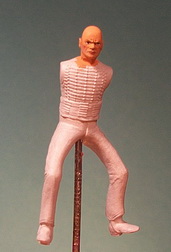 |
Figure 3 - The entire kit was built from Historex
spare parts which I have accumulated over the last 30 or so years.
Well, I did have to order a couple of parts to complete the kit.
This view shows the torso, legs, and the MIG Productions 54mm resin
head. Note that it does not have a collar which I will make
from sheet lead, a simple thing to do.
Figure 4 - The resin replacement
head does not have a collar; so, one has to be fashioned. I
use lead sheet material as shown in Figure 4. After
determining the correct height of the collar, I cut one end at 45
degrees and super glued it in place as shown. After drying,
the material is easily bent around the neck. Another 45 degree
cut is made to close the collar.
|
Figure 4
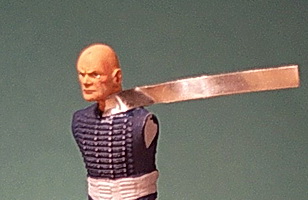 |
|
Figure 5
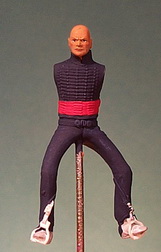 |
Figure 5 - The collar has been
"incorporated" into the uniform. Note also the waist belt
which is also a strip of sheet lead adorned with the Historex buckle
super glued over the joint. I painted the figure's jacket and
trousers with my mix of "French" dark blue. The Historex
stirrups have lead sheet straps with the Historex stirrup leathers
loops. They are super glued to the bottom of the boots, tucked
just behind the knee, and super glued there. The waist belt is
painted in Vallejo VC0946 Dark Red to which will be added yellow
barrels.
|
|
|
|
Figure 6 at right shows the placement of the busby
which has had its "fur" run over by a pyrogravure "hot tool".
The Busby "bag" is red without tassel. The basic uniform is
dark blue with yellow piping and braid. The campaign overalls
are dark blue with double yellow stripes down the outside seams.
Boots a semi-gloss black.
|
Figure 6
 |
|
Figure 7
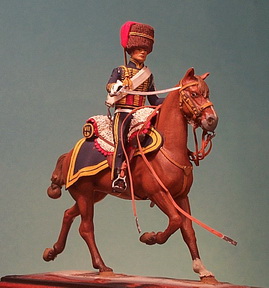 |
Figure 7 is the figure mounted on the horse.
The cartridge box and carbine slings were made from strips of sheet
lead. Where each joins in the back, a buckle was glued to hide
the join. These belts and the sword belt are painted with a
mix of Vallejo VC0950 Flat White and my pre-mixed off-white.
Yellow cap lines encircle the busby. These are
made from fine copper strands taken from No. 12 house wire.
Another pair of wires exits the rear of the busby, fall to the
shoulder, and are glued to the top right row of the dolman's
buttons. From that point, raquettes are glued.
The white sheepskin shabraque is blued over the
cloth shabraque making sure that the portmanteau bearing the unit's
identity "VII LD" fits. Other details are explained in the
next panel. The light brown reins on this side of the horse
have yet to be attached.
|
|
|
|
Figure 8 at illustrates several additions.
Where the sword belt crosses the left hip, two holes were drilled.
In each was glued a combination of the a sword and sabretache sling
with the sword slings on the inside so the sabretache falls to the
outside. The slings were made from strips
of lead sheeting, primed, and painted in a white mix described in
the panel above. Note the rear of the cartridge box and
carbine slings showing how the buckle hides the join of the lead
strip belting.
The hussars campaign trousers, as shown in panel 6
above, had semi-gloss black paint applied to the inside to represent
the leather insert sewn to the trousers that bore on the saddle
leathers to prevent wear.
The arms are glued in position after the figure is
mounted to be sure that there is clearance; otherwise, the arms
would have to be adjusted.
|
Figure 8
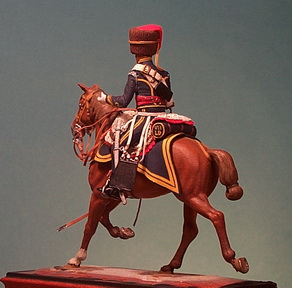 |
|
Figure 9
 |
Figure 9 is the completed figure, right side view.
Reins have been attached to the right side. All reins,
shabraque leather, and stirrup leathers were painted with a mix of
Vallejo VC0856 Ochre Brown (50%) and VC0981 Orange Brown (50%).
Saddle leather was painted with Andrea ANAC42 Red Leather, stained
with ANAC48 Dark Leather, and washed with semi-gloss clear. The
specific bits used are Historex Spare HXS367 British light cavalry
and Royal Horse Artillery style bits. The carbine has been
attached to its sling: ANAC17 Medium Brown stock, VC0864 Natural
Steel barrel and lock, and VC0801 Brass for other metal fittings.
The busby plume is white with a red base (Vallejo
VC0947 Red). More than likely, the pelisse was left in storage
in Brussels. It was generally worn during cold weather.
It was hung from the left shoulder for parade.
|
|
|
|
Figure 10 is the completed figure,
left side view. Each Historex mounted kit
comes with a sprue of four horse shoes so I have
quite a few spares. I only add them to the
bottom of hooves that are visible. They a
glued on, dried, sanded to fit, and painted with
Vallejo VC0864 Natural Steel.
The exact uniform worn by the 7th
Hussars at Waterloo is not known for sure. It
is possible that they wore medium gray campaign trousers
with brown leather inserts. The number and
color of the stripes could have been single or
double, red or yellow. I have chosen dark blue
based on the Fosten plate in The Thin Red Line,
Plate 12.
The highly detailed and costly cloth
shabraque was probably left in England and a
simpler, dark blue one was used on campaign.
|
Figure 10
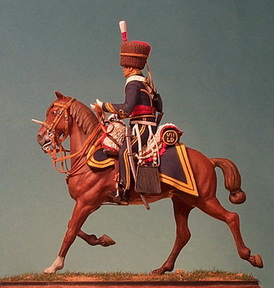 |
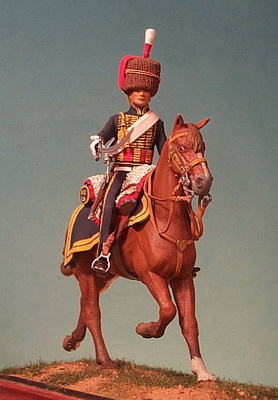

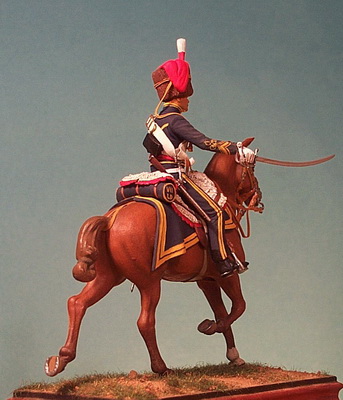
****** FINIS ******
BIBLIOGRAPHY
Bowden, Scott. Armies at Waterloo. Arlington,
TX: Empire Game Press, 1983.
Fosten, Brian. Wellington's Light Cavalry,
Osprey Men-at-Arms No. 126. London, UK: Osprey Publishing Ltd., 1982.
Fosten, DSV and BK. The Thin Red Line, Plate No.
12, Hussars 1815.
Hackbridge, Wallington, UK: Pimpernel Studios, 1986.
Pimlott, John. British Light Cavalry, Nations in
Arms 1800-1815. London, UK: Almark Publishing Ltd., 1977.
Wood, Evelyn, General Sir, V.C. Cavalry in the
Waterloo Campaign. East Felling, Tyne & Wear, UK; Worley
Publications, 1991 (reprint).
Wooten, Geoffrey. Waterloo 1815 - Osprey Campaign
Series No. 15. London, UK: Osprey Publishing Ltd, 1992.
GO TO?
© Copyright by George Grasse











